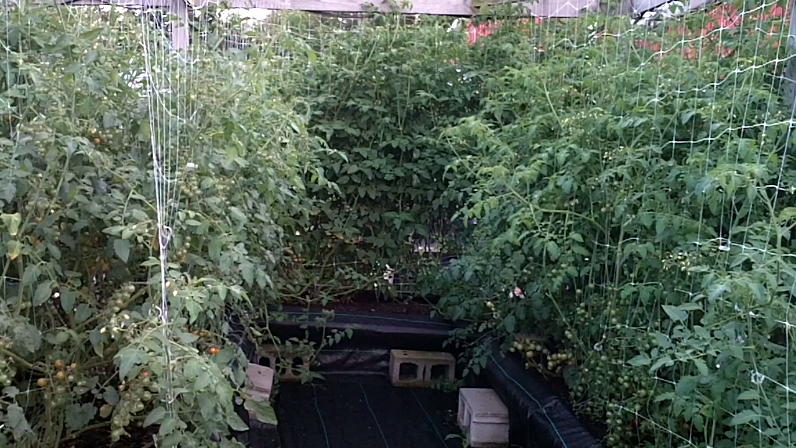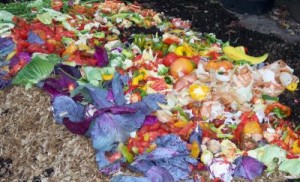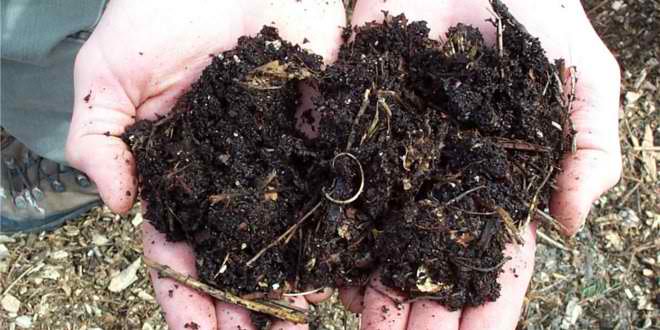It is amazing how simple gardening becomes when you stop treating your soil like dirt. If you want to make it easier, to grow larger harvests, of more nutritious food — just make your soil come alive. Enhance your soil with biologically rich conditioners — use fertilizers that feed the soil biosystem — and you will begin to enjoy gardening more and have much greater success.
If there was one tip that I could give gardeners, it would be to learn to put billions of soil microbes to work for you. If you don’t believe me, just come up and watch our plants grow — it’s incredible — and so simple! Think soil — not dirt.

There are only 6 tomato plants here in 3 planters — with our living soil — and they were way too crowded. We had a hard time reaching the tomatoes in the center of the plants.
Use living soil, not dead dirt
Many gardeners will waste a lot of money again this spring on sterilized ‘organic dirt’. It may have the words ‘organic’ and ‘soil’ on the label, but inside, it’s just ‘dirt’. Peat moss products and bagged soil conditioners can help to improve the physical structure of your soil but they do very little when it comes to feeding and rapidly increasing soil microbe populations — or getting your soil biologically prepared for your plants — or holding on to plant nutrients.
Soil microbes prefer oxygen rich soils. Bagging soils — and stacking them on pallets squeezes out most of the oxygen and the microbes start to die off. Big soil operations have to bag and ship soils months in advance because of problems associated with shipping and selling so much of a bulky item, so quickly in the spring. But, the longer the bags sit, the more dead microbes you have. It may say it is a composted soil product on the bag, but it’s compost treated like dirt.
Our compost and soils are made in small batches and we leave it bagged it for only short periods. Since the greatest contribution that compost makes to your garden are the microbes it contains, you get a lot more for your money with fresh soil products.
Our compost
“Diversity in starting materials means diversity of food, and diversity of beneficial organisms” said Dr. Ingham referring to compost quality. Our compost is made from the waste products of our salad mix — things like organic kale stems, organic carrots, organic peppers, organic mustard greens, and organic cabbage. It is nutrient rich with a great diversity of microbes and sold at just the right time.
There is a cycle that a compost pile goes through — and there is a window of time where each batch is most alive. Once our pile is big enough, or we need compost, we stop adding fresh organic matter and let the pile sit for a few weeks. Then we till the pile to grind the partially decomposed organic matter down to a smaller size and thoroughly mix in the microbes that have begun to grow in the pile.
The microbe population explodes because the smaller size of the ground organic matter provides a greater surface area for even more microbes to grow on. After a few weeks, the pile starts to cool down — the microbe population starts to die back again.
We bag and sell our compost when the piles are most biologically active. It is timed and ready to seed your garden with massive populations of the best friends a plant can have.
Our potting soil
Our potting soil is great! It makes growing big, healthy plants much easier. I actually feel bad for the plants (and the people) when I see someone that has purchased brand name artificial soils. They used to call them soil-less mixes years ago, and at the time it seemed like a good thing. Now we know those mixes are really just fancy dirt.
Our potting soil uses fresh compost that is amended with fertilizers, kelp, rock powders, and more beneficial microbes. We add an assortment of organic matter that keeps the soil looser by breaking down more slowly. Our potting soil brings all of the benefits of fresh compost to your containers with adequate drainage — without perlite — and without peat moss. Plants grow better in it because it holds nutrients better and because more nutrients are absorbed by the plants due to the microbes.
Our leaf humus
We also carry leaf humus. This is a very inexpensive way to add organic matter and beneficial microbes to your garden. Although it is not as nutrient rich as our compost (which is made from organic veggies), it is a very cost effective soil conditioner. It is ground and sifted — a very high quality product made entirely from local leaves.
Rice hulls
I like the idea of using an organic waste product like rice hulls that rice companies are trying to find a use for instead of a product like perlite, or vermiculite so we tried it when it came to our attention — and guess what — it works better too. The difference was so noticeable that we switched over to rice hulls immediately last spring.
Using waste products to grow plants instead of filling landfills makes a lot of sense in an organic garden. We use locally composted leaves instead of peat moss that was mined and shipped from great distances, and rice hulls that rice companies are tying to find a use for instead of a mined and processed product like perlite, or vermiculite.
Compost at this stage is teeming with microbes to inoculate your garden soil.
Our seeding flats are now constantly under the watch of predatory soil mites (see video below). One of the benefits of living soils is that natural controls seem to emerge for many problems. In this case, the mites came with our seedstarting mix which is made from very fresh compost.
When fungus gnats showed up, the mite population swelled up and brought the fungus gnats under control.They are also busy searching for other soil insects like Thrips, Springtails, and Root-knot nematodes. Without enough pests for food, they can switch to a vegetarian diet of algae or even plant debris.
Natural controls like this are lost from soils that have been bagged for any period of time.


